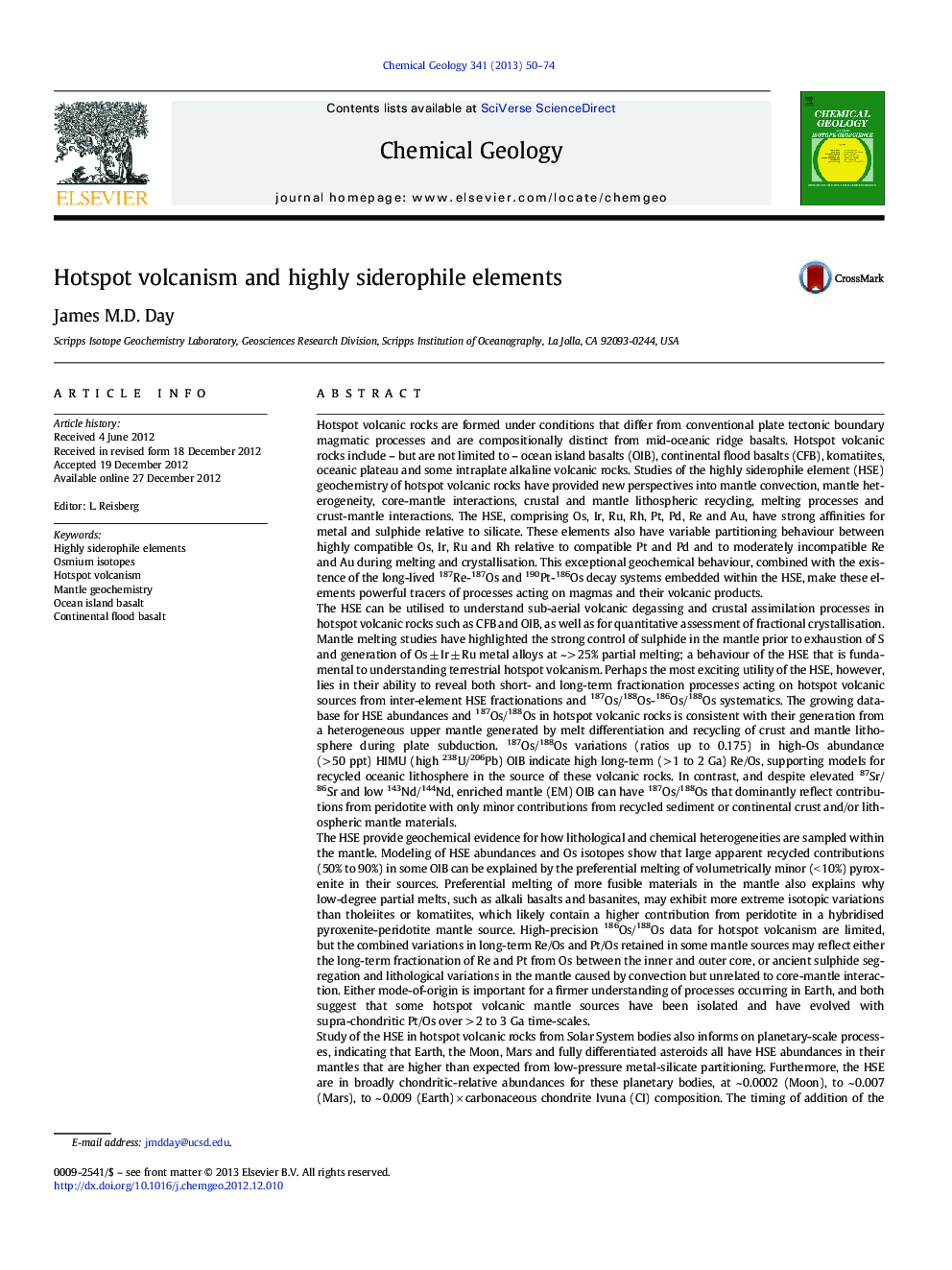| کد مقاله | کد نشریه | سال انتشار | مقاله انگلیسی | نسخه تمام متن |
|---|---|---|---|---|
| 4699038 | 1637627 | 2013 | 25 صفحه PDF | دانلود رایگان |

Hotspot volcanic rocks are formed under conditions that differ from conventional plate tectonic boundary magmatic processes and are compositionally distinct from mid-oceanic ridge basalts. Hotspot volcanic rocks include – but are not limited to – ocean island basalts (OIB), continental flood basalts (CFB), komatiites, oceanic plateau and some intraplate alkaline volcanic rocks. Studies of the highly siderophile element (HSE) geochemistry of hotspot volcanic rocks have provided new perspectives into mantle convection, mantle heterogeneity, core-mantle interactions, crustal and mantle lithospheric recycling, melting processes and crust-mantle interactions. The HSE, comprising Os, Ir, Ru, Rh, Pt, Pd, Re and Au, have strong affinities for metal and sulphide relative to silicate. These elements also have variable partitioning behaviour between highly compatible Os, Ir, Ru and Rh relative to compatible Pt and Pd and to moderately incompatible Re and Au during melting and crystallisation. This exceptional geochemical behaviour, combined with the existence of the long-lived 187Re-187Os and 190Pt-186Os decay systems embedded within the HSE, make these elements powerful tracers of processes acting on magmas and their volcanic products.The HSE can be utilised to understand sub-aerial volcanic degassing and crustal assimilation processes in hotspot volcanic rocks such as CFB and OIB, as well as for quantitative assessment of fractional crystallisation. Mantle melting studies have highlighted the strong control of sulphide in the mantle prior to exhaustion of S and generation of Os ± Ir ± Ru metal alloys at ~ > 25% partial melting; a behaviour of the HSE that is fundamental to understanding terrestrial hotspot volcanism. Perhaps the most exciting utility of the HSE, however, lies in their ability to reveal both short- and long-term fractionation processes acting on hotspot volcanic sources from inter-element HSE fractionations and 187Os/188Os-186Os/188Os systematics. The growing database for HSE abundances and 187Os/188Os in hotspot volcanic rocks is consistent with their generation from a heterogeneous upper mantle generated by melt differentiation and recycling of crust and mantle lithosphere during plate subduction. 187Os/188Os variations (ratios up to 0.175) in high-Os abundance (> 50 ppt) HIMU (high 238U/206Pb) OIB indicate high long-term (> 1 to 2 Ga) Re/Os, supporting models for recycled oceanic lithosphere in the source of these volcanic rocks. In contrast, and despite elevated 87Sr/86Sr and low 143Nd/144Nd, enriched mantle (EM) OIB can have 187Os/188Os that dominantly reflect contributions from peridotite with only minor contributions from recycled sediment or continental crust and/or lithospheric mantle materials.The HSE provide geochemical evidence for how lithological and chemical heterogeneities are sampled within the mantle. Modeling of HSE abundances and Os isotopes show that large apparent recycled contributions (50% to 90%) in some OIB can be explained by the preferential melting of volumetrically minor (< 10%) pyroxenite in their sources. Preferential melting of more fusible materials in the mantle also explains why low-degree partial melts, such as alkali basalts and basanites, may exhibit more extreme isotopic variations than tholeiites or komatiites, which likely contain a higher contribution from peridotite in a hybridised pyroxenite-peridotite mantle source. High-precision 186Os/188Os data for hotspot volcanism are limited, but the combined variations in long-term Re/Os and Pt/Os retained in some mantle sources may reflect either the long-term fractionation of Re and Pt from Os between the inner and outer core, or ancient sulphide segregation and lithological variations in the mantle caused by convection but unrelated to core-mantle interaction. Either mode-of-origin is important for a firmer understanding of processes occurring in Earth, and both suggest that some hotspot volcanic mantle sources have been isolated and have evolved with supra-chondritic Pt/Os over > 2 to 3 Ga time-scales.Study of the HSE in hotspot volcanic rocks from Solar System bodies also informs on planetary-scale processes, indicating that Earth, the Moon, Mars and fully differentiated asteroids all have HSE abundances in their mantles that are higher than expected from low-pressure metal-silicate partitioning. Furthermore, the HSE are in broadly chondritic-relative abundances for these planetary bodies, at ~ 0.0002 (Moon), to ~ 0.007 (Mars), to ~ 0.009 (Earth) × carbonaceous chondrite Ivuna (CI) composition. The timing of addition of the HSE to planetary bodies preserved in their magmas and volcanic products is consistent with Solar-System-wide late accretion no later than 3.8 Ga for Earth, and even earlier based on evidence from the Moon (~ 4.4 Ga), Mars (~ 4.5 Ga) and asteroids (> 4.56 Ga).
► Highly siderophile element (HSE) abundances and Os isotopes are powerful tools for understanding hotspot volcanism.
► There is strong evidence for recycling of oceanic lithosphere into some hotspot volcanics (OIB and CFB).
► Higher degree melting leads to larger contribution from peridotite relative to more fusible materials (e.g., pyroxenite).
► Osmium isotopes allow tracing of high (Pt+Re)/Os sources in volcanic rocks and possible core-mantle interactions.
► Solar System-wide volcanism ubiquitously derive from mantles with chondrite-relative HSE abundances.
Journal: Chemical Geology - Volume 341, 11 March 2013, Pages 50–74